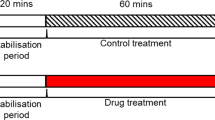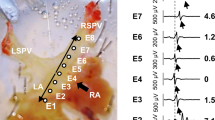Abstract
THE sinus venosus or the atrium of the frog heart was dissected, cut open, and bathed in Ringer's solution containing sodium-24. When equilibrium had been reached between intracellular and extracellular activity the preparation was mounted in a small chamber through which a rapid stream of inactive Ringer's solution flowed. The activity of the preparation was determined by a scintillation counter in short intervals. After elimination of the extracellular activity the curve which represents the remaining activity consists of two exponential components with time constants of about 10 min and 100 min, respectively1. The slow component can directly be determined at the end of a loss curve, and the fast component is evaluated by graphical analysis (Fig. 1). The sum of the two components at zero time is equal to the intracellular sodium content as determined by flame photometry2. The flux Φ through the cell membranes is defined by the initial values A1 A2 and the time constants τ1, τ2 of the two components:  The beating rate of the preparation was kept constant throughout the experiment by electrical stimulation at 2–3 times the spontaneous rate of the preparation. Moreover, the effect of changes in frequency on the loss curve was tested and was found to be minimal for the slow component, but an increase in outflow of sodium could clearly be shown for the fast component2.
The beating rate of the preparation was kept constant throughout the experiment by electrical stimulation at 2–3 times the spontaneous rate of the preparation. Moreover, the effect of changes in frequency on the loss curve was tested and was found to be minimal for the slow component, but an increase in outflow of sodium could clearly be shown for the fast component2.
This is a preview of subscription content, access via your institution
Access options
Subscribe to this journal
Receive 51 print issues and online access
$199.00 per year
only $3.90 per issue
Buy this article
- Purchase on Springer Link
- Instant access to full article PDF
Prices may be subject to local taxes which are calculated during checkout
Similar content being viewed by others
References
Haas, H. G., Pflügers Arch. ges. Physiol. (in the press).
Haas, H. G., and Glitsch, H. G., Pflügers Arch. ges. Physiol., 274, 13 (1961).
Castillo, J. del, and Katz, B., Nature, 175, 1035 (1955).
Hutter, O. F., and Trautwein, W., J. Gen. Physiol., 39, 715 (1956).
Author information
Authors and Affiliations
Rights and permissions
About this article
Cite this article
HAAS, H., TRAUTWEIN, W. Increase of Sodium Efflux induced by Epinephrine in the Heart of the Frog. Nature 197, 80–81 (1963). https://doi.org/10.1038/197080a0
Issue Date:
DOI: https://doi.org/10.1038/197080a0
This article is cited by
-
Electrophysiological effects of potassium and calcium ions in the sino-atrial node in response to sympathetic nerve stimulation
Pfl�gers Archiv European Journal of Physiology (1969)
-
Effects of adrenaline on membrane inward currents during the cardiac action potential
Pfl�gers Archiv European Journal of Physiology (1969)
-
Orientierende Übersicht
Ergebnisse der Physiologie Biologischen Chemie und Experimentellen Pharmakologie (1966)
Comments
By submitting a comment you agree to abide by our Terms and Community Guidelines. If you find something abusive or that does not comply with our terms or guidelines please flag it as inappropriate.



